Mary Anne Yarde's Blog: The Coffee Pot Book Club , page 173
July 16, 2018
Author’s Inspiration ~ Vicky Adin #amwriting #HistoricalFiction @VickyAdin
An Author’s Inspiration
Why I am who I am today: an author.
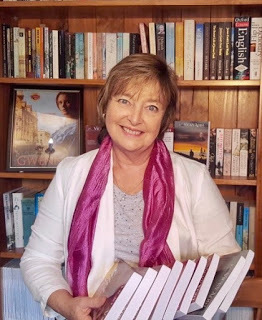 A series of events, bereavements and a degree of bullying led me to become a mature university student - something I had never considered possible. Decades earlier, a similar set of reasons had forced me to leave school, needing to work. Writing was something I had once enjoyed at school, but beyond that I never gave it a second thought. I worked. I married. I had children. We moved several times, because of my husband’s work and I stayed home looking after the children, as women usually did in those days. And because I stayed home, I read voraciously.
A series of events, bereavements and a degree of bullying led me to become a mature university student - something I had never considered possible. Decades earlier, a similar set of reasons had forced me to leave school, needing to work. Writing was something I had once enjoyed at school, but beyond that I never gave it a second thought. I worked. I married. I had children. We moved several times, because of my husband’s work and I stayed home looking after the children, as women usually did in those days. And because I stayed home, I read voraciously. I’ve always been a reader. From my earliest memory, I had a book in my hand and by the time I was a teen I was hooked on historical fiction. That love of history stories never left me. As the years passed, I became interested in family history and joined the genealogy society and started researching the past. What I was going to do with all this information beyond building the family tree I had no idea. Not until much later.
What I now know is, that if I hadn’t gone to university when I did I would not have started writing. I didn’t need a degree that led to a career, and taking an Arts degree allowed me to take subjects that appealed to me. I enjoyed my study so much I went on to do a Master of Arts in English and Adult Education graduating with First Class Honours. I’d almost decided to do a PhD (because I could) when my supervisor suggested I should publish my work. Since I knew my thesis would be published, I wasn’t sure what he meant. Publish? Publish what?
A memory returned. I hunted amongst my files for my essays for a creative writing course and there, in black and white, was a handwritten note. “You write well. You should publish.” And then I saw a letter from the university hierarchy after a particularly good exam result on Irish Literature, which also advised me to look at publishing.
For the first time, I knew I had something to write about.
Genealogy did more for me than putting family into groups and knowing who begat whom and where they lived. What fascinated me was the life they lived, the struggles they overcame and the incredibly tough decisions they made. Leaving everything and everyone they knew in their homeland to travel across the oceans to an unknown land far away took courage and determination. Life was not easy, but there were opportunities and possibilities if they worked hard – especially for the women. It was these stories I wanted to bring to life. The real names as such, didn’t matter. They could be my ancestors or yours, or anyone else’s in this new country. But their story did matter.
I didn’t sign up for my Ph.D. I joined a writing group instead and learnt to write a novel. To begin with I knew my style was too formal and academic. One of the group told me to take a section and turn the whole thing into dialogue. That was my turning point. Suddenly, words became simpler, explanations easier, and emotions clearer. Of course, I couldn’t write the whole book as dialogue, but it was a start. University had given me another vital skill – how to research. So, I researched, I wrote, rewrote, ditched it, picked it up again and had another author beta read it for me and pull it to pieces. She did so - kindly, and told me to keep writing. I was a good writer.
After five years of struggle, I released my first book in 2011. ‘The Disenchanted Soldier’, is written as a time-slip novel about a researcher digging into the past and discovering what her ancestors had achieved. Then came ‘The Cornish Knot’ and ‘The Art of Secrets’ both contemporary novels with female protagonists who trace their own family tree and uncover secrets from the past which free them from the world they feel trapped in. ‘The Girl from County Clare’ and my latest release ‘Gwenna’ have historical settings. Both stories are about young girls with uncommon determination in Victorian times when women were expected to stay at home and leave business to their menfolk. These girls thought differently.
All my stories are inspired by immigrants to this country, the struggles they faced and the results they achieved.
It took the belief others had in me to turn me into a writer. I am so grateful to them all for showing me the path. The more I write, the more I learn, the more I write. Book 6 is in the mashing pot. For more information, you can sign up to my newsletter, and follow me on Facebook and Twitter.

Vicky AdinAward-winning historical fiction author, Vicky Adin is a genealogist in love with history and words.
After decades of research Vicky has combined her skills to weave family and history stories together in a way that brings the past to life.
Fascinated by the 19th Century pioneers who undertook hazardous journeys to find a better life, especially the women, Vicky draws her characters from real life stories: characters such as Brigid, the Irish lacemaker and Gwenna, the Welsh confectioner, or Megan who discovers much about herself when she traces her family tree in The Cornish Knot.
Vicky Adin holds a MA(Hons) in English and Education. She is an avid reader of historical novels, family sagas and contemporary women’s stories and enjoys travelling.
Published on July 16, 2018 23:00
July 15, 2018
So, did Alfred really burn the cakes? by Chris Bishop #vikings #saxons #alfredthegreat @CBishop_author
So, did Alfred really burn the cakes?By Chris Bishop
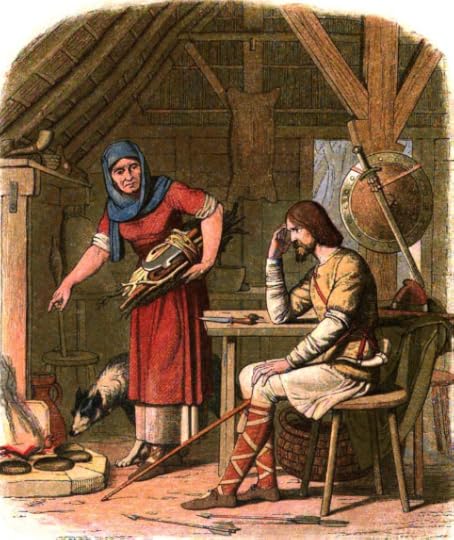 A Victorian portrayal of the 12th-century legend of Alfred burning the cakes ~ Wikipedia
A Victorian portrayal of the 12th-century legend of Alfred burning the cakes ~ Wikipedia Whilst you might not think this to be the most important question ever asked about one of the truly revered figures from English history, it is the one most frequently posed whenever I give talks about my novels in The Shadow of the Raven series, all of which feature Alfred the Great.
Of course, the answer is that we’ll never know whether or not the story is true. It’s one of those strange ‘facts’ which have emerged from the misty realms of folklore and have somehow managed to survive the ravages of both time and historical interpretation. As such it’s easy to dismiss it as trivial nonsense yet even now, over 1000 years after it is supposed to have happened, it can reveal a good deal more than you might think about what was going on at this crucial turning point in English history.
To explain what I mean let me quickly summarise the backdrop to the story. England was all but dominated by the Vikings following the Great Invasion in 865 until Alfred’s realm of Wessex stood alone. Alfred (and his older brother Aethelred) did sterling work in holding back the Vikings, fighting numerous battles and skirmishes in an attempt to drive them from Wessex. Unfortunately, apart from Ashdown where the Saxons were successful, none of the battles were decisive and most could best be described as a ‘no score draw’ until, in 877, Alfred, no doubt weary and needing to regroup, returned to his Royal Vill at Chippenham for the winter. Whilst there, a surprise Viking attack led by Guthrum left his army all but annihilated and Alfred, we’re told, was forced to flee with a small band of survivors to hide out in the desolate marshes in the Somerset Levels. It is from this wretched period that the story of the cakes emanates – along with others.
Actually, recent archaeological findings may suggest that Alfred was not quite as isolated as we might have previously thought. For example, there is the suggestion that Ceolwulf II, the ruler of the neighbouring realm of Mercia, was also involved in the all-important Battle at Edington later that same year when the Saxons at last managed to turn the tide of the Viking invasion. However, the evidence for Ceolwulf’s part in this is far from conclusive. It rests on some coins which have been found from this period depicting both rulers side by side, suggesting that Alfred enlisted (or perhaps accepted) help from Ceolwulf. Does this infer two realms coming together to fight a common enemy or did they form an alliance once victory had been achieved?
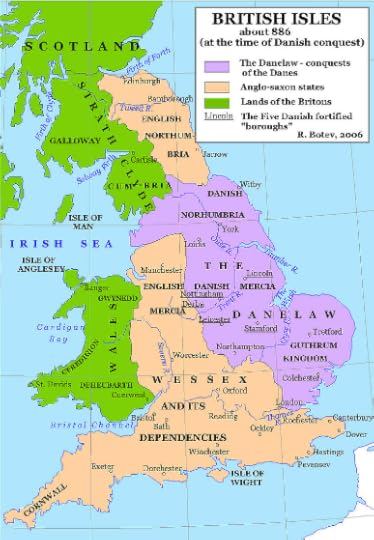 Map of Britain in 886 ~ Wikipedia
Map of Britain in 886 ~ WikipediaSetting that aside, we can only imagine how devastating that defeat at Chippenham would have been for a man who stood to lose his entire Kingdom to the Vikings. Also, to go from the comfort of his Royal Vill to sheltering in the marshes would have been a severe blow not just to Alfred’s ego and his pride, but to his confidence as well. The marshes would have been a bleak and depressing place, particularly in winter, with precious little to commend them beyond the fact that they were probably a relatively safe place in which to hide – as I say in my novel, Blood and Destiny, Alfred would have gone there for one simple reason - the Vikings would not. Whatever the truth of that, it does at least put Alfred in the right place at the right time for the story about the cakes to be true.
It’s easy to envisage the situation where Alfred, ever determined, sets about planning how best to strike back – no easy task when most Saxons would have had their fill of battles and, anyway, many people probably thought him either dead or to have fled abroad. Some sort of covert mechanism for rallying what was left his army would have been needed, supported by tactics which can probably best be described as guerrilla warfare – striking when and where he could. It is generally accepted that he would have established a base within the marshes for that very purpose (the ‘Isle’ of Athelney is thought by many to have been a possible site for this) but in undertaking various raids he would have had to venture further afield and would doubtless have identified some isolated settlements where he could safely seek temporary shelter. Thus the prospect of him stopping off at one of these is certainly not an unreasonable proposition and, if he did, it is not too hard to think in terms of him resting whilst his host, supposedly a poor and wretched soul, went about her tasks. So why then did this great King abuse this poor woman’s hospitality and allow her cakes to be ruined?
The answer must surely lie in the fact that Alfred would have had a great deal on his mind at the time and a huge responsibility on his shoulders. Hardly surprising then that he was so distracted as to take his mind off such a menial task. If we want to be pedantic we could ask why the most important man in the realm was alone at this time – and assuming he wasn’t, why one of the others could not have been given the more mundane task of minding a few cakes leaving Alfred to concentrate on planning his come-back, rebuilding his kingdom and saving his people from the ravages of the Viking invaders. It is also recorded that Alfred was sometimes unwell, suffering from an inflammation of the gut (possibly Crohn’s Disease?) which may have been made worse by the stress of all he had endured and by the discomfort of living within the cold damp marsh through the winter. Might such a debilitating complaint have contributed to his being distracted?
So, from what we have so far it does seem plausible to assume that the incident couldhave happened. But there is a major flaw – having burned the cakes, it is said that the woman scolded him for his inattention to what, to her, would have been a very important task – preparing food for the table.
Well, let’s just look at that for a moment. Given that he was under attack, Alfred probably left Chippenham in haste with little more than his weaponry and the clothes on his back. Certainly it’s unlikely that he would have had any regalia or robes that might reflect his status and, whilst we don’t know exactly when the cakes incident is supposed to have taken place, even if it happened after only a few weeks of living rough, it’s reasonable to assume that Alfred would have looked dishevelled and well the worse for wear. Also, Wessex was the last piece in the Viking’s invasion jigsaw and they had only to capture Alfred in order to complete it and thereby secure their domination of all England. Thus the price on Alfred’s head would have been enormous - certainly enough to tempt someone to betray him and, in those circumstances, it’s not unreasonable to think of him disguising himself, with his true identity being known only to the small band of survivors whose loyalty was beyond question and whose fate was inextricably bound with his own. To achieve this, he may well have presented himself as just another ragged and destitute soul who had been driven from his home and thus the poor woman who offered him shelter may have had no idea who she was taking in. However, I have to question whether that is a realistic contention. Alfred, and those with him, would surely have had their war gear and weapons, particularly if they were indeed carrying out raids on Viking targets and positions. That alone should have marked them out as being at least of noble blood and for a lowly coerl or peasant woman to scold her betters over such a trivial matter as a few cakes seems highly improbable.
So, even finding Alfred in the right place at the right time and being able to envisage the circumstances in which he might have been seeking shelter at a humble abode, the story doesn’t quite hold water. However, there is another story which also stems from this period which suggests that Alfred disguised himself as a wandering minstrel and actually entered the Viking camp to learn what he could of Guthrum’s plans. That also makes little sense given all that was at stake for Alfred personally – not just the loss of his Kingdom, but also the prospect of a gruesome death given that the Viking’s hated spies and reserved some particularly brutal torments for those they caught! However, if you consider the two stories together there is a common thread depicting traits such as humility and bravado which are often ascribed to the heroes from our past – Robin Hood who robbed the rich and gave to the poor being a case in point. Folklore seems to embrace characteristics like these and so perhaps that’s what we’re hearing with both stories about Alfred – tales which spring from the popular culture of the time, perhaps originating in the tradition of oral story telling which is how most people would have heard and repeated them at the time. If so they are probably not entirely without foundation. Alfred was indeed a man of the people. Being the youngest of five brothers, he was never destined to be King in the first place, particularly as at that time succession was more a matter of selection rather than birthright. He earned the right to rule Wessex on the battlefield, proving himself a skilled and daring military commander. But, by the same token, he was also a very religious man, the depth of his faith perhaps stemming from the fact that as boy he twice made a pilgrimage to Rome which is thought to have made a huge impression on him. This would have been an important consideration at the time given that the Saxons were themselves a deeply religious people.
Put his military skill and his religious convictions together and you begin to understand why Alfred, as great warrior King, not only had the resolve and determination to win back his kingdom (when many probably thought that impossible) but he was also driven by an altruistic desire to improve things for all his subjects. That was a rare thing in those days when social justice could be described as rudimentary at best and it might well explain why these affectionate and flattering stories were founded - and why they endured. If that is indeed the case it is a much more significant part of Alfred’s story than the burning of a few cakes.
Actually, they probably weren’t cakes at all – they were more likely to be small loaves of bread but I find the image of those battle hardened Saxon warriors sitting down to scoff a few cakes between battles (burnt or otherwise) an endearing one. That said, I do wonder how or why a woman somewhere in or near the dank marshes at Athelney was cooking enough cakes to share – and where she got the ingredients in the middle of winter when large swathes of the realm were probably starving!
Most likely, wherever and however the story originated it has since been embellished by others over the centuries (including the Victorians who held Alfred in particular esteem), so much so that the truth of it is probably lost forever. Frankly I’m not sure it matters all that much if it is. The story of Alfred has served as both an inspiration and a role model throughout history to such an extent that if he hadn’t existed, we would probably have had to invent him. He is one of the few men in the history of the world to be afforded the title ‘Great’ which reflects all that he achieved – so what does it matter if his skills didn’t extend to baking a few cakes?
The Warrior With The Pierced Heart
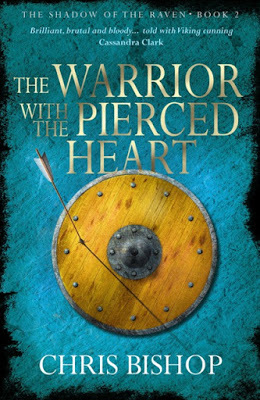 Despite his great victory at Edington, Alfred’s Kingdom is far from secure as bands of restless Vikings still roam free, armed and intent on vengeance.Matthew is charged with carrying news of Alfred’s triumph ahead of the main Saxon army to rally support. But his mission goes dreadfully wrong when he and his small escort are all but destroyed in a surprise Viking attack. Seriously wounded, Matthew is left for dead but, for reasons of her own, a mysterious pagan healer helps to heal his wounds. His adventures thereafter take him to the very depths of despair as he strives to return to his king - and to the woman he loves. But fate stalks him like a shadow and he endures much hardship and cruelty along the way - and is forced to fight for his life just to survive.AVAILABLE FROM ALL GOOD BOOKSHOPS AND ONLINEAmazon Waterstones
Despite his great victory at Edington, Alfred’s Kingdom is far from secure as bands of restless Vikings still roam free, armed and intent on vengeance.Matthew is charged with carrying news of Alfred’s triumph ahead of the main Saxon army to rally support. But his mission goes dreadfully wrong when he and his small escort are all but destroyed in a surprise Viking attack. Seriously wounded, Matthew is left for dead but, for reasons of her own, a mysterious pagan healer helps to heal his wounds. His adventures thereafter take him to the very depths of despair as he strives to return to his king - and to the woman he loves. But fate stalks him like a shadow and he endures much hardship and cruelty along the way - and is forced to fight for his life just to survive.AVAILABLE FROM ALL GOOD BOOKSHOPS AND ONLINEAmazon Waterstones Or your local independent retailer
Chris Bishop
 Chris Bishop is the author of
The Shadow of the Raven Series
, a trilogy set at the time of Alfred the Great. Part 1 –
Blood & Destiny
- was published in 2017 and Part 2 –
The Warrior with the Pierced Heart
- in July this year. Part 3 - The Final Reckoning - will be published next year.Chris is a member of the Historical Writers’ Association and the Historical Novels Society.Chris loves to hear from readers, you can find him: Website Twitter
Chris Bishop is the author of
The Shadow of the Raven Series
, a trilogy set at the time of Alfred the Great. Part 1 –
Blood & Destiny
- was published in 2017 and Part 2 –
The Warrior with the Pierced Heart
- in July this year. Part 3 - The Final Reckoning - will be published next year.Chris is a member of the Historical Writers’ Association and the Historical Novels Society.Chris loves to hear from readers, you can find him: Website Twitter
Published on July 15, 2018 23:00
July 12, 2018
#NewRelease ~ Love’s Whisper by Dorothy Wiley #HistoricalFiction @WileyDorothy
Love’s WhisperBy Dorothy Wiley
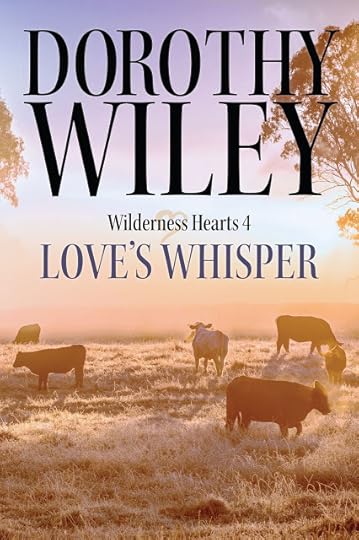
A heart-pounding novel of a love that must truly conquer all.In 1811, strengthened by his own struggles and triumphs, Liam Roberts earned the respect of his commanding officers and his current boss, cattleman Stephen Wyllie. Although Liam considers himself a homebody, he lacks a home. Tired of bunkhouse life, and twenty-five-years-old, he is ready for a home of his own and a family.Polly Wyllie, Stephen’s nineteen-year-old bookish daughter, has graduated from an academy for young ladies. Liam and Polly’s fourteen-year-old brother, Samuel, are sent to escort her home. But their return to Wyllie Cattle Farm is endangered by a vicious hurricane-spawned thunderstorm that threatens their lives. The storm is only the beginning of the troubles and predicaments Polly and Liam must face while their attraction to each other grows. And when Liam brings a young orphan into their lives, their blossoming relationship grows even more complex. But the worst test Polly must face is one she never expected—shocking news that changes everything.Danger and beauty, trials and heroism, faith and family, at the heart of the American frontier. A sweet historical romance set against the stunning backdrop of the Kentucky wilderness.LOVE’S GLORY is the highly-anticipated tenth book in Wiley’s best-selling novels of the American frontier. Presented in the American Wilderness Series and the Wilderness Hearts Series, the highly-rated and award-winning novels in these two series will capture your heart and touch your soul.
Excerpt
The storm outside still raged as Liam watched Polly’s peaceful sleep. But the sudden sound of flowing water inside the cave jolted Liam from his thoughts of Polly. Liam sprang up and went to look. The fire illuminated a stream of water now rushing through the other side of the cave where it was somewhat lower than where they were. The stream swelled and flowed toward the cave opening with a speed that increased even as he watched. He hurried to the cave opening and peered outside. At least five inches of water surrounded the cave opening and it appeared to be rising fast.“Wake up!” Liam yelled.“What is it?” Polly asked, sitting up. “An animal?”“No! Get dressed!” Liam ordered.“I’m still sleepy,” Samuel said groggily.“Wake up! Water’s pouring into the cave. It will soon flood. Get dressed. Quickly!” Liam instructed as he swiftly did the same. “Liam, how bad is it?” Polly asked as she found her spectacles. He could hear the worry in her voice.His heart thumped with his own apprehension. He had to get Polly and Samuel to safety. “It’s been raining on and off all night, mostly on and dreadfully heavy at times.” He knew that unfortunate fact because he’d slept little, tending the fire most of the night to be sure it stayed burning and kept the other two warm. Worried now about flash flooding, he said, “We have to get out of here and on the trail again as soon as we can.”Samuel slowly stood up and looked around for his clothes.“Samuel, Hurry!” Polly admonished.“I am,” he said.“Hurry faster,” Liam admonished in a stern voice and then stuck his pistols in his belt and buttoned his coat. Next, he heaved his saddle over his horse and, after tightening the straps, he wrapped his rifle in doeskin and shoved it into his saddle sheath. Polly finished throwing on her clothes, not bothering with buttons, and while she hurriedly saddled her mount, Liam saddled Samuel’s horse. The horses hadn’t been fed since early yesterday morning and Liam knew they would grow weak if they didn’t get nourishment soon.“Thanks,” Samuel said slipping the headstall over his horse’s head. “I’m sorry I was so slow. I was just so sleepy.”“Liam, the water is coming in faster,” Polly said, with a worried glance at the much larger stream spilling into the cave.Liam heard deep gurgling and a steady gushing of water coming from somewhere in the darkness at the back of the cave. A flash flood was now pouring through the cave's passages toward them. That meant trouble. The cave could flood in mere moments. No wonder there were no animals living in here.Polly yelped when waterfalls started shooting out of the ceiling and the sound of rushing water became thunderous as it echoed in the cave. Their situation was fast becoming a watery nightmare.“Out now!” Liam ordered.
Amazon US Amazon UK
Dorothy Wiley
 Amazon bestselling novelist Dorothy Wiley is an award-winning, multi-published author of Historical Romance and Western Frontier Romance. Wiley’s two series, the highly-acclaimed American Wilderness Series and Wilderness Hearts Series, blend thrilling action-packed adventures with the romance of a moving love story to create exceedingly engaging page-turners enjoyed worldwide by her readers. With an average Amazon rating of 4.6 stars and more than a thousand five-star reviews, Wiley is one of the most highly-rated Amazon authors.Like Wiley’s compelling heroes, who from the onset make it clear they will not fail despite the adversities they face, this author is likewise destined for success. In the last three years, her novels have won numerous awards, notably a RONE Award Finalist; a 2016 Laramie Award Finalist; a Chatelaine Finalist for Romantic Fiction; an Amazon Breakthrough Novel Award Quarter-finalist; a Readers’ Favorite Gold Medal; a USA Best Book Awards Finalist; and a Historical Novel Society Editor’s Choice. Her books continue to earn five-star ratings from readers and high praise from reviewers, including a Crowned Heart from InD’Tale Magazine.Wiley’s extraordinary historical romances, inspired by history, teem with action and cliff-edge tension. Her books’ timeless messages of family and loyalty are both raw and honest. In all her novels, the author’s complex characters come alive and are joined by a memorable ensemble of friends and family. As she skillfully unravels a compelling tale, Wiley includes rich historical elements to create a vivid colonial world that celebrates the historical heritage of the frontier. Wiley attended college at The University of Texas in Austin, Texas. She graduated with honors, receiving a bachelor of journalism, and grew to dearly love both Texas and a 7th-generation Texan, her husband Larry. Her husband’s courageous ancestors, early pioneers of Kentucky and Texas, provided the inspiration for her novels. After a distinguished career in corporate marketing and public relations, Wiley is living her dream—writing novels that touch the hearts of readers. All of Wiley’s books are available in print and eBooks and most in audiobooks at Amazon US or in the UK at Amazon UK For further information, please visit her websiteor Facebook.
Amazon bestselling novelist Dorothy Wiley is an award-winning, multi-published author of Historical Romance and Western Frontier Romance. Wiley’s two series, the highly-acclaimed American Wilderness Series and Wilderness Hearts Series, blend thrilling action-packed adventures with the romance of a moving love story to create exceedingly engaging page-turners enjoyed worldwide by her readers. With an average Amazon rating of 4.6 stars and more than a thousand five-star reviews, Wiley is one of the most highly-rated Amazon authors.Like Wiley’s compelling heroes, who from the onset make it clear they will not fail despite the adversities they face, this author is likewise destined for success. In the last three years, her novels have won numerous awards, notably a RONE Award Finalist; a 2016 Laramie Award Finalist; a Chatelaine Finalist for Romantic Fiction; an Amazon Breakthrough Novel Award Quarter-finalist; a Readers’ Favorite Gold Medal; a USA Best Book Awards Finalist; and a Historical Novel Society Editor’s Choice. Her books continue to earn five-star ratings from readers and high praise from reviewers, including a Crowned Heart from InD’Tale Magazine.Wiley’s extraordinary historical romances, inspired by history, teem with action and cliff-edge tension. Her books’ timeless messages of family and loyalty are both raw and honest. In all her novels, the author’s complex characters come alive and are joined by a memorable ensemble of friends and family. As she skillfully unravels a compelling tale, Wiley includes rich historical elements to create a vivid colonial world that celebrates the historical heritage of the frontier. Wiley attended college at The University of Texas in Austin, Texas. She graduated with honors, receiving a bachelor of journalism, and grew to dearly love both Texas and a 7th-generation Texan, her husband Larry. Her husband’s courageous ancestors, early pioneers of Kentucky and Texas, provided the inspiration for her novels. After a distinguished career in corporate marketing and public relations, Wiley is living her dream—writing novels that touch the hearts of readers. All of Wiley’s books are available in print and eBooks and most in audiobooks at Amazon US or in the UK at Amazon UK For further information, please visit her websiteor Facebook.
Published on July 12, 2018 23:00
July 11, 2018
Where history meets magic? By Mary Morgan #Ireland #Celtic #Romance @m_morganauthor
Where history meets magic!By Mary Morgan
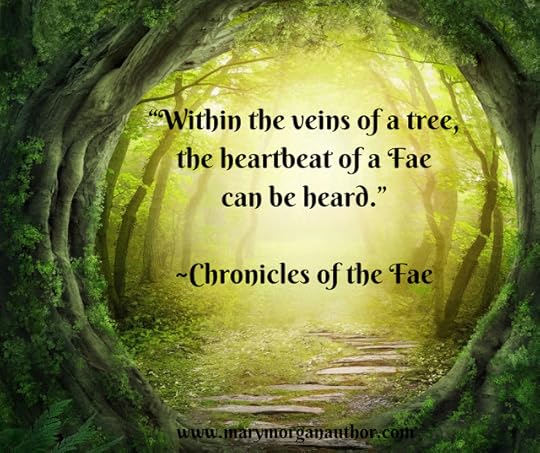
I have always been fascinated with Celtic Mythology, so it only made sense that I would develop and expand the world of the Fenian Fae Warriors. Theirs was a world rich in legends, colors, and senses. I’ve based my own fictional account on the legend of the Tuatha de Danann—one of the invasions of Ireland. They were known as the Shining Ones or the Fae. And I’m not talking about the demure faeries you’ve seen portrayed in Victorian stories and artwork. These Fae are generally described as tall with red or blonde hair, blue or green eyes, and pale skin. Of course, I’ve added my own fictional descriptions and ideas within my stories.
The Tuatha de Danann were defeated in two battles by the Milesians, whom historians and scholars alike agree were probably the first Gaels in Ireland. It was agreed that the new invaders (Milesians) and the Tuatha de Danann would each rule half of Ireland. Therefore, it was that Amergin of the Milesians chose that half of Ireland, which lay above ground, leaving the Tuatha de Danann to retreat below. They were led underground by Manannán mac Lir, God of the Sea, who shielded them with an enchanted mist from mortal eyes. As time passed, they became known as the Sidhe (Shee), or Ireland’s faery folk.
In doing research for Oath of a Warrior, Legends of the Fenian Warriors, Book 2 , I came across hundreds of cases pertaining to witches and the witch trials in Scotland. The records of Scotland’s witch trials spanned a period of over 200 years during the 16th and 17th centuries. However, I did find evidence of several women being burned, or executed in the late 15th century. This was a dark period in Scottish history, exposing a culture of fear and panic that cast a cloud over much of Scotland.
Some of the charges brought against these individuals ranged from belonging to a coven, receiving herbs from the Queen of the Faeries, and using charms against another person. It did not matter if you were a servant or upper class, either. If you wanted to rid yourself of someone, all you had to do was accuse a person of being a witch.

The heroine, Erina MacIntyre, was a wonderful character to write and one I knew who would appeal to my Fae hero, Rory MacGregor. She loved her garden and animals, tended to those who required healing, made love charms, and believed in the old ways. A perfect combination for any to accuse her of dealing in the black arts. Yet, she never saw herself as a witch. Only someone who was different. Sadly, even in this century, we tend to look at others who do not walk the same path as the majority as odd.
I hope you’ve enjoyed my own twist on history, legends, and mythology. As I’ve often stated, “history is only as good as the bard weaving the tale.”
Oath of a Warrior
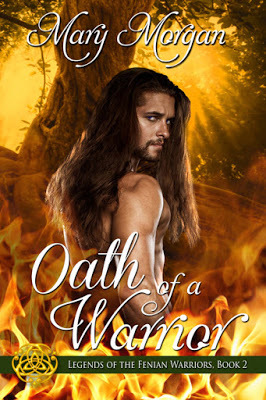 "You met them in the Order of the Dragon Knights. Now, journey to the realm of the Fae and witness their legends!"
"You met them in the Order of the Dragon Knights. Now, journey to the realm of the Fae and witness their legends!"Fenian Warrior, Rory MacGregor’s love conquests are legendary, but he has never spoken of the one mortal female who captured his heart. After his dark secret is finally revealed, he is ordered to return and seal the wounds left open by her death. Yet, he finds the timeline altered and swears an oath to rewrite fate, even if it brings about his own death.
Erina MacIntyre is known for her healing herbs and love charms. Determined to aid others, she refuses to listen to the whispers that call her a witch. When a Highlander steps forth into her path, he ignites a thread of strange familiarity and sparks a flame of desire she is unable to control.
Can the destiny of two lovers find love once more among the ashes of death and betrayal? Or will history repeat itself, leaving a scorching path of destruction for both mortals and Fae alike?
Amazon• BN(Nook)• iTunes• Kobo
Mary Morgan
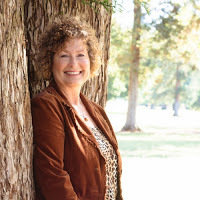 Award-winning Celtic paranormal romance author, Mary Morgan, resides in Northern California, with her own knight in shining armor. However, during her travels to Scotland, England, and Ireland, she left a part of her soul in one of these countries and vows to return.
Award-winning Celtic paranormal romance author, Mary Morgan, resides in Northern California, with her own knight in shining armor. However, during her travels to Scotland, England, and Ireland, she left a part of her soul in one of these countries and vows to return.
Mary's passion for books started at an early age along with an overactive imagination. She spent far too much time daydreaming and was told quite often to remove her head from the clouds. It wasn't until the closure of Borders Books where Mary worked that she found her true calling--writing romance. Now, the worlds she created in her mind are coming to life within her stories.
If you enjoy history, tortured heroes, and a wee bit of magic, then time-travel within the pages of her books.
Mary loves to hear from readers, you can find her: Website• Blog • Twitter • Facebook Author Page • Goodreads • Amazon Author Page • Pinterest • Instagram.
Published on July 11, 2018 23:00
July 10, 2018
Author’s Inspiration ~ Christy Nicholas #amwriting #History @greendragon9
Author’s Inspiration
Misfortune of Time
By Christy Nicholas

In the past, I’ve tried to address particular issues as a subplot of my novels. I’ve showcased things such as the Great Hunger in Ireland, forced marriage, or marginalized populations.
However, Misfortune of Time deals with a difficult subject – abuse. In order to get a proper feel of the horror of this situation, I interviewed three friends, all of whom suffered from spousal abuse. Gretchen, Ian, and Lindsay were all kind enough to give me anecdotes (which is a hopelessly innocent word for such stories) of their time with their partners. Examples of gaslighting, physical and emotional abuse, using a child as a tool to inflict harm. In the course of this research, while writing the novel, the explosion of the #metoo movement came into popular media coverage. The sheer volume of voices shouting against the centuries of injustice have finally become too loud to drown out in misogynistic bullying. The legion of men (and women) who are being brought down by the increasing cries of abuse increases every day. While some may be false cries or exaggerations, the vast majority will be true accusations, shattering the previously impervious armor of Establishment and Custom. In my book, I try to highlight the fact that this abuse is NOT new. It is endemic to many cultures, many times, many people. The only way to minimize this abuse is to make it not normal. The only way to remove it from normalcy is to call it out as something unacceptable whenever it’s encountered. The wolf whistle on the subway or the condescending mansplaining in the board room, both need to be called out.I also wanted to portray the heroine, Étaín, as someone who isn’t young and naïve. An abuse victim can be any age. Even if she ‘knows better’, if she’s had abusive partners in the past, she is MUCH more likely to find herself in another abusive relationship. The spiraling self-doubt is not easily cured. Étaín has lived many lifetimes thanks to a magical brooch that allows her to maintain her age. Despite her years of experience, she once again falls into a marriage with a husband who becomes abusive. And yet, she stays to protect her grandson, despite being beaten to within an inch of her life.For all the men and women that struggle from day to day with their partner, their parent, their sibling, their boss, whomever is in their life and abusing their trust, believe that there is not only hope, there is avenue for escape. There are friends who will help. There are agencies designed to extract you and your children. There are options for each and every one of you.People care. They really do care. If you cannot believe that, remember that your brain can lie to you. If my novel reaches one person and convinces them of the above, then all the hard work and research that went into writing it will have been worth it. All it takes is one life made better.
Misfortune of TimeBook #6 of The Druid’s Brooch Series
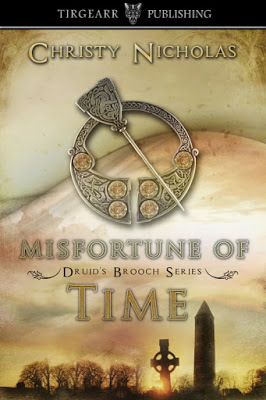 In 11th century Ireland, Étaín must hide her pagan magic from her pious Christian priest husband, Airtre. She wants to escape his physical abuse, but she must stay to protect their grandson, Maelan. Over many lifetimes, she has learned how to endure her own pain, but Maelan is young and vulnerable.
When Airtre's paranoia and jealousy spiral out of control, Étaín has no choice but to escape in the night with little more than the clothing on her back, leaving a trusted friend to protect Maelan.
This is not the first lifetime Étaín has fled, and she knows how to survive. But when her past comes back to haunt her, she must make decisions that may result in disaster for her, her grandson, and everyone she loves.Amazon • Tirgearr Publishing
In 11th century Ireland, Étaín must hide her pagan magic from her pious Christian priest husband, Airtre. She wants to escape his physical abuse, but she must stay to protect their grandson, Maelan. Over many lifetimes, she has learned how to endure her own pain, but Maelan is young and vulnerable.
When Airtre's paranoia and jealousy spiral out of control, Étaín has no choice but to escape in the night with little more than the clothing on her back, leaving a trusted friend to protect Maelan.
This is not the first lifetime Étaín has fled, and she knows how to survive. But when her past comes back to haunt her, she must make decisions that may result in disaster for her, her grandson, and everyone she loves.Amazon • Tirgearr PublishingChristy Nicholas
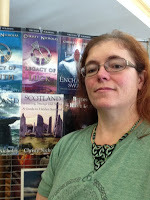 Christy Nicholas, also known as Green Dragon, is an author, artist and accountant. After she failed to become an airline pilot, she quit her ceaseless pursuit of careers that begin with ‘A’, and decided to concentrate on her writing. Since she has Project Completion Disorder, she is one of the few authors she knows with NO unfinished novels.Christy has her hands in many crafts, including digital art, beaded jewelry, writing, and photography. In real life, she’s a CPA, but having grown up with art all around her (her mother, grandmother and great-grandmother are/were all artists), it sort of infected her, as it were.She wants to expose the incredible beauty in this world, hidden beneath the everyday grime of familiarity and habit, and share it with others. She uses characters out of time and places infused with magic and myth.Combine this love of beauty with a bit of financial sense and you get an art business. She does local art and craft shows, as well as sending her art to various science fiction conventions throughout the country and abroad.Christy loves to hear from readers, you can find her: Website•
Christy Nicholas, also known as Green Dragon, is an author, artist and accountant. After she failed to become an airline pilot, she quit her ceaseless pursuit of careers that begin with ‘A’, and decided to concentrate on her writing. Since she has Project Completion Disorder, she is one of the few authors she knows with NO unfinished novels.Christy has her hands in many crafts, including digital art, beaded jewelry, writing, and photography. In real life, she’s a CPA, but having grown up with art all around her (her mother, grandmother and great-grandmother are/were all artists), it sort of infected her, as it were.She wants to expose the incredible beauty in this world, hidden beneath the everyday grime of familiarity and habit, and share it with others. She uses characters out of time and places infused with magic and myth.Combine this love of beauty with a bit of financial sense and you get an art business. She does local art and craft shows, as well as sending her art to various science fiction conventions throughout the country and abroad.Christy loves to hear from readers, you can find her: Website•Blog • Facebook • Twitter
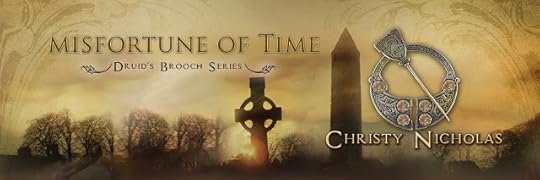
Published on July 10, 2018 23:00
July 9, 2018
Book Spotlight ~ The Draughtsman Damsel by Emily Klein #Medieval #HistoricalRomance @Ekleinfolktales
The Draughtsman Damsel By Emily Klein
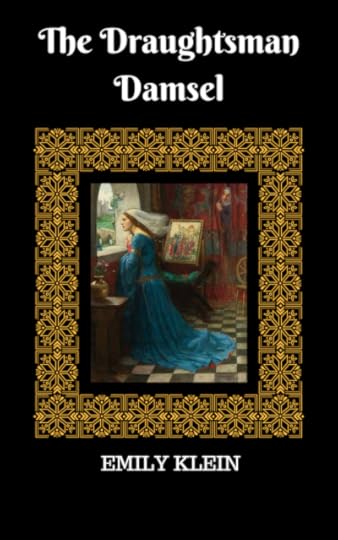 Annabelle's father, Lord Latimer, is the closest counsellor and architect to the Duke at Calais. But when the King of England calls him back to court, he is forced to go, tearing his ten-year-old daughter, Annabelle, from her home and from her best friend, the Duke's youngest son, Thomas.
At the English court, Annabelle grows up to be a sensitive, precocious damsel. She has a penchant for mathematics and drawing, but bears an aversion to the “female arts” required of a well-bred nobleman's daughter. So much so, the she contrives a ruse to avoid them; a ruse that risks her eligibility as a bride, as well as her governess and tutor's livelihoods.
The Duke, her family's former benefactor, now estranged, wants Lord Latimer to return to Calais and help finish his grand castle, a massive monument to chivalry. So, when a courtship party turns to a fiasco, her parents make use of returning to Calais to further educate their wayward daughter, who is now left with no tutor or governess. When they arrive, however, nothing goes as planned. Pride, politics, madness, and falling unwittingly and unwillingly in love complicate matters to the point of disaster. A story of love and friendship, politics and science, castles and knights, maidens and romance, set in medieval England and France. ExcerptHe had been riding all morning, in quest of solitude, and solace for his aching soul and buzzing mind, but he too could not achieve it . Annabelle’s image kept appearing before his eyes, causing a dull, sweet ache in his chest. He loved her, and he knew it now. But it was to no avail, as he knew that they would not be permitted to wed, and what worse, she loved him not, he was almost certain. When he saw a feminine form, sitting at the tree, resembling his true love, he thought his mind was deceiving him. That in his desperation he was seeing a mirage of her, but decided to approach and find out. He was alarmed and delighted at the same time to learn that it was, in fact, she, of whom he had been thinking. It was as if he had conjured her into being, just by his deep, desperate contemplation of her, and that, as well as the prospect of being in close encounter with her, alone, frightened him, for he knew not the amount of self-control he would be able to muster around her, withholding from her his feelings for her, withholding his touch. “My lady” he said, removing his cap. “Is it you, my lady Annabelle?” “Yes, my lord,... of course... I...” She answered, not sure what this odd question could mean “I am sorry if I seem odd to you, my lady. It is a strange thing to encounter in real form, in flesh and blood, that which one has been conjuring in one’s mind’s eye, all morning.” Annabelle did not know what this meant, or what to reply to this, for she was not quite sure how such a statement made her feel. What was more, she was still apprehensive about being alone with him. He approached closer, and without asking her leave, sat himself down next to her. Annabelle’s heart was leaping in its ribcage, though were it only for apprehension or for something else, quite different, she was not sure. “It is not like me to be so unsure of my own mind and heart” she thought “but it seems to be ever my wont whenever Thomas is in my presence. This is a dangerous thing, to be out of her faculties, for any lady who finds herself alone with a gentleman.”Thomas could sense her apprehension and knew that he must give her reassurance “my lady, you should know by now, that you need never fear me. Do you not know that?” “I do, my lord, and I am not afraid. It is only that I am not accustomed to being in the presence of a man, un- chaperoned and away from any source of help. “though she knew that she was very efficient in escaping such situations. “ “Very well, my lady... Annabelle...” and he looked directly at her. “I felt like you were angry with me after our conversation, I felt as if we were a breath away from resuming our friendship, and that it was no longer within our reach. My lady, Annabelle...”He took a deep breath and swallowed, for he wished very much to tell her that he loved her, to embrace her, caress her head and smooth her curls, and kiss her lips, but her cold demeanour and apprehension stopped him from doing so, and he resumed “May we not be friends once more, sweet Belle?” On hearing him address her with her childhood name, the shortened version of her Christian name, she was instantly hit with the image of him kissing Cecily, of him calling her “Cice” for short, and for endearment, and felt a tidal wave of rage and sorrow wash over her, and she answered, enunciating each word with great intention “No, we may not, my lord, for your falseness deters me from it.” she rose from her seat, went to her Little Grey, and rode away from him.Amazon US Amazon UK
Annabelle's father, Lord Latimer, is the closest counsellor and architect to the Duke at Calais. But when the King of England calls him back to court, he is forced to go, tearing his ten-year-old daughter, Annabelle, from her home and from her best friend, the Duke's youngest son, Thomas.
At the English court, Annabelle grows up to be a sensitive, precocious damsel. She has a penchant for mathematics and drawing, but bears an aversion to the “female arts” required of a well-bred nobleman's daughter. So much so, the she contrives a ruse to avoid them; a ruse that risks her eligibility as a bride, as well as her governess and tutor's livelihoods.
The Duke, her family's former benefactor, now estranged, wants Lord Latimer to return to Calais and help finish his grand castle, a massive monument to chivalry. So, when a courtship party turns to a fiasco, her parents make use of returning to Calais to further educate their wayward daughter, who is now left with no tutor or governess. When they arrive, however, nothing goes as planned. Pride, politics, madness, and falling unwittingly and unwillingly in love complicate matters to the point of disaster. A story of love and friendship, politics and science, castles and knights, maidens and romance, set in medieval England and France. ExcerptHe had been riding all morning, in quest of solitude, and solace for his aching soul and buzzing mind, but he too could not achieve it . Annabelle’s image kept appearing before his eyes, causing a dull, sweet ache in his chest. He loved her, and he knew it now. But it was to no avail, as he knew that they would not be permitted to wed, and what worse, she loved him not, he was almost certain. When he saw a feminine form, sitting at the tree, resembling his true love, he thought his mind was deceiving him. That in his desperation he was seeing a mirage of her, but decided to approach and find out. He was alarmed and delighted at the same time to learn that it was, in fact, she, of whom he had been thinking. It was as if he had conjured her into being, just by his deep, desperate contemplation of her, and that, as well as the prospect of being in close encounter with her, alone, frightened him, for he knew not the amount of self-control he would be able to muster around her, withholding from her his feelings for her, withholding his touch. “My lady” he said, removing his cap. “Is it you, my lady Annabelle?” “Yes, my lord,... of course... I...” She answered, not sure what this odd question could mean “I am sorry if I seem odd to you, my lady. It is a strange thing to encounter in real form, in flesh and blood, that which one has been conjuring in one’s mind’s eye, all morning.” Annabelle did not know what this meant, or what to reply to this, for she was not quite sure how such a statement made her feel. What was more, she was still apprehensive about being alone with him. He approached closer, and without asking her leave, sat himself down next to her. Annabelle’s heart was leaping in its ribcage, though were it only for apprehension or for something else, quite different, she was not sure. “It is not like me to be so unsure of my own mind and heart” she thought “but it seems to be ever my wont whenever Thomas is in my presence. This is a dangerous thing, to be out of her faculties, for any lady who finds herself alone with a gentleman.”Thomas could sense her apprehension and knew that he must give her reassurance “my lady, you should know by now, that you need never fear me. Do you not know that?” “I do, my lord, and I am not afraid. It is only that I am not accustomed to being in the presence of a man, un- chaperoned and away from any source of help. “though she knew that she was very efficient in escaping such situations. “ “Very well, my lady... Annabelle...” and he looked directly at her. “I felt like you were angry with me after our conversation, I felt as if we were a breath away from resuming our friendship, and that it was no longer within our reach. My lady, Annabelle...”He took a deep breath and swallowed, for he wished very much to tell her that he loved her, to embrace her, caress her head and smooth her curls, and kiss her lips, but her cold demeanour and apprehension stopped him from doing so, and he resumed “May we not be friends once more, sweet Belle?” On hearing him address her with her childhood name, the shortened version of her Christian name, she was instantly hit with the image of him kissing Cecily, of him calling her “Cice” for short, and for endearment, and felt a tidal wave of rage and sorrow wash over her, and she answered, enunciating each word with great intention “No, we may not, my lord, for your falseness deters me from it.” she rose from her seat, went to her Little Grey, and rode away from him.Amazon US Amazon UKEmily Klein
 Emily Klein is an author of historical romance novels, set in medieval times. She is a staunch anglophile, with a keen interest in anything and everything British, and a fierce love for the English language, and all its dialects. She also has an interest in history, including, but not limited, to medieval history. Emily also enjoys antiques and vintage clothing. In short, if it's part of history, Emily Klein will find it interesting. Emily loves to hear from readers, you can find her: Twitter
Emily Klein is an author of historical romance novels, set in medieval times. She is a staunch anglophile, with a keen interest in anything and everything British, and a fierce love for the English language, and all its dialects. She also has an interest in history, including, but not limited, to medieval history. Emily also enjoys antiques and vintage clothing. In short, if it's part of history, Emily Klein will find it interesting. Emily loves to hear from readers, you can find her: Twitter
Published on July 09, 2018 23:00
July 8, 2018
Author's Inspiration ~ A tower as a protagonist? By Sarah Dahl #NewRelease #Vikings #HistoricalRomance @sarahdahl13
Author’s Inspiration
A tower as a protagonist? By Sarah Dahl
This new Tale of Freya, “Tower”, is the one I spent most time and rewrites on. It started out as a straightforward erotica piece, then I decided it needs more grit and adventure … and I got lost, ending up with a half-baked novella. I reworked it several times, let it rest for long stretches, and eventually knew how to rewrite it so it would fit in my collection of sensual Tales. I kept the main characters, a young Viking called Myskia who sets out on a revenge mission to rescue the women abducted by their arch-enemey, the notoriously brutal Raven. He has to duel the enemy and then enters a strange building – one he has never seen before and which houses several surprises for our fearless warrior …
For a long time I didn’t really know where exactly my story was set and what the source of my character’s feud was. But with the reworking for the collection Tales of Freya, “Tower” needed a clearer setting, characters and plot. During all rewrites, the story always evolved around its unique and unusual setting: a round tower like those I encountered in Ireland. So the main protagonist is maybe not our young, passionate Viking, but this imposing stone structure that challenges Myskia. The history of these kind of round towers in Ireland is unclear. Their exact age is unknown as is their purpose. They could have been bell towers, they could have held crops or valuables. Who exactly built them, when, and why – it’s not proven, and therefore intriguing as a setting. Also, this unclear history gives me creative writing freedom!
I can make the building what I want it to be for my story. And in this story, after a fierce and brutal duel, I wanted Myskia to end up in a very confined space. Here he should meet his lover again, Adisa, taken from him by the enemy as a slave. How will this first encounter be, after months of their different nightmares? I wanted to oppose them like in an intimate chamber play. Give them time to digest that they are suddenly back together – and that they aren’t the same people as before. Slavery changed Adisa, in several ways. So Myskia, who came to snatch her back and run, has to find that all is not that easy. He has to use all his skills to break down the walls of our tower, and then those that have grown between him and his beloved woman.
I started out with these Irish round towers because they fascine me just as much as they are an exotic pull for Myskia – and a great setting for what evolves once he gets face to face with Adisa. I made the interior as confined, narrow and intimidating as I needed it to be. The real towers are too old and crumbling to tell what would still be authentic, and so I let my imagination run wild. In this intimate setting and with the traumatic experiences of especially Adisa, her encounter with Myskia would be explosive. In many ways.
There is sensuality, yes, but only after they go through a whole array of emotions at their sudden meeting, in a setting they’re unable to flee from: shock, realisation, denial, rage, and accusations. The tower witnesses and contains it all, with just the two of them working through it. But there is also this deep-rooted bond they still share, and if Myskia is gentle with her, me might just be given enough time to break through their mental walls and get to what is at the core of their love: trust, connection, infinite attraction, and the courage to be vulnerable. Naked in minds and bodies, no matter how battered and bruised our protagonists are after all these months of separation. This bond our couple share is much stronger than they thought. They can find back to what they once had – in a different, deeper way – but first, they have to get out of the tower alive.
Tower – Unchained by Love (The sixth Tale of Freya) By Sarah Dahl
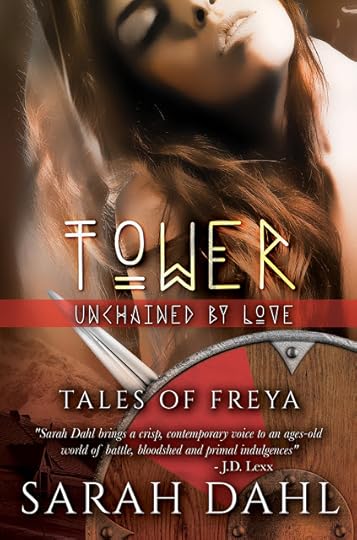
From her collection of sensual short stories set in the Viking Age.
In a world of crackling fires and rough landscapes, long winters and bloody raids, the immediacy of life and death ignites undeniable passions. Warriors and monks, healers and housewives -- all follow the call of their hearts and bodies to indulge in pleasures that may forever change their lives.
Young Viking Myskia lands on Irish shores to rescue his lover Adisa from the clutches of his family's enemy Raven. After a fierce duel, Myskia finds himself in the confined walls of a strange tower, facing Adisa. Their reunion turns out to be very different than what he imagined. Can the passion they once shared break down the walls that have grown between them after months of slavery? Or has she changed in ways he’s unprepared for?
Set in the Viking era, this is a stand-alone, adult read with a HEA.
Excerpt
Adisa’s fingertips touched Myskia’s tunic, hesitant. Trembling hands slowly pushed up the blood-soaked fabric. Her cheeks coloured more with every inch of skin she revealed.
He whispered, "It's just me, Adisa. You've done this before."
The shirt slid to the floor. She stood still. Her gaze wandered over the mud, grease, and blood on his forearms and neck. "I've never seen you like this. You look," her finger shyly traced his shoulder, "so strong when you're this dirty." Her laugh sounded incredulous.
He didn't laugh. "But you were the strong one."
Eyes closed, she ran a finger down the bulge of his biceps. A slow smile spread on her face which was now heated from something other than rage.
His heartbeat sped up. "Don't push it, Adisa …. You wouldn't want them to find us," he looked straight at her, "making love?"
Her eyes flew open, and the blush deepened. "You!" She thumped a fist against his chest. "But yes. When we're home I want you to erase him from my mind, Myskia. Replace his cruel hands with yours."
"That should be easy." He slid his finger up her scarred arms and under the fabric of her sleeves, caressing her tormented skin. Goosebumps erupted under his touch. It felt amazing. He reached out to caress her cheek. "I'll make you forget."
Their lips met, and careful, tender, sparks prickled from his mouth to his neck, lighting a fire that set his entire skin alight. He saw: The fire in her eyes had not died. The realisation made his heart jump with joy. Moulding her against him, he tipped back the hood. His finger traced the line of her neck, felt soft hair rise at his touch. "We might not get out with our lives."
A shiver ran through her. "If we don't make it back, if they catch us —"
His hands ran down her arms, grabbed her hands. "Then we'll at least have celebrated our reunion."
Amazon
Sarah Dahl
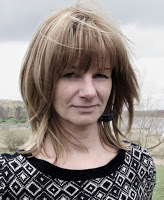 Sarah Dahl lives on the edge of the rural German Eifel and writes historical fiction primarily set in the Viking age. She also works as an editor, translates, and coaches new writers in German and English. She is interested in everyday life in bygone centuries and the human stories that may have occurred behind the hard, historical facts.
Sarah Dahl lives on the edge of the rural German Eifel and writes historical fiction primarily set in the Viking age. She also works as an editor, translates, and coaches new writers in German and English. She is interested in everyday life in bygone centuries and the human stories that may have occurred behind the hard, historical facts.Sarah loves to hear from readers, you can find her: Website and BlogMailing ListFacebook Twitter
Published on July 08, 2018 23:00
July 5, 2018
Blog Tour ~ The King’s Justice by E.M. Powell #Medieval #Historical @hfvbt @empowellauthor
Historical Virtual Book Tour Presents....
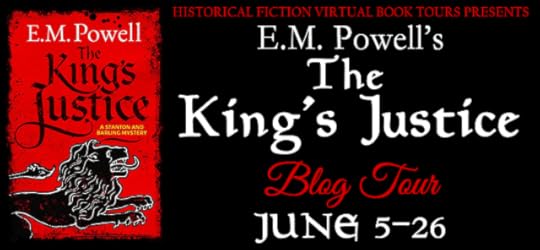
Author’s Inspiration By E.M. Powell
When Mary Anne so generously offered this guest post as part of my blog tour for THE KING’S JUSTICE, the first in my new medieval mystery series, I was a) excited by the topic and b) went to double check the definition of ‘inspiration’ in the Oxford English Dictionary.
The reasons for my reaction are not complex. Authors are solitary beasts and are always excited when anybody at all in the wider world asks them about their books. This is largely in response to authors’ nearest and dearest running for the hills whenever the topic of writing is mentioned. It is a sad fact, dear reader, that loved ones’ eyes glaze over when an author is relating a screamingly funny anecdote over dinner about a misplaced modifier in the last paragraph of the now deleted draft of chapter 4.
Aside from the rush of another real live human being interested in the writing process, I’m a historical fiction author and our knee jerk reaction to any project is to go check the facts. Usually at least three times, and with as many reliable sources as we can get our hands on. So off I went to the OED. And I found this: ‘Inspiration: A breathing in or infusion of some idea, purpose, etc. into the mind; the suggestion, awakening, or creation of some feeling or impulse, esp. of an exalted kind.’
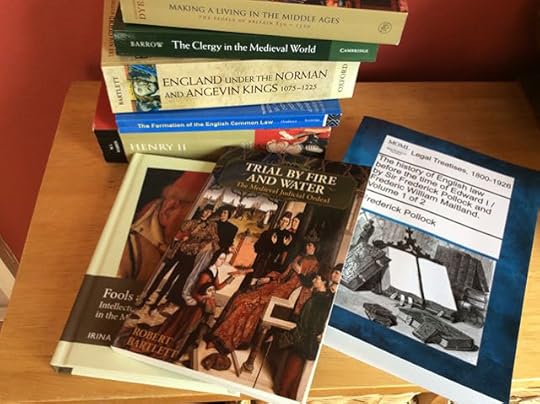
Exalted? Oh, my. What of course happened next is what always happens in research. I needed to check the Thing I’d found out when I went to check the original Thing. Here’s the OED again: ‘Exalted: Of feelings, powers, sentiments, states of the mind. Carried to a high degree; intense. Of persons: Impassioned
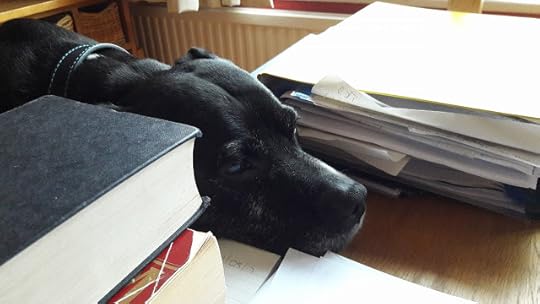
Then I did what authors also do, which is commonly misinterpreted as Staring out of The Window but what I like to call Having a Think. Mock us not: it really, really is something that is necessary. And just as it was something that I needed to do in order to decide what to write for this post, it’s something that I have to do when writing a novel.
I can best explain it this way. You know that feeling you get when you’re reading a novel and have become totally engrossed in it? It’s like you have gone to another world. The real world around you seems to have totally receded. You may not even hear people speaking to you or asking for your attention. You can be in an airport lounge and almost miss your flight. You can be on a train that’s jam-packed with commuters and you have no idea that anybody else is anywhere near you. The story has hold of you and that’s where your mind has gone.
Well, it’s the same when writing that story. And not only is the author immersed in that other mindset, the author is having to keep a multitude of plates spinning at once: Characters. Plot. Secret Plot, if it’s a mystery. Dialogue. Narrative. Historical details. Timeline. Drop one, and the whole story can collapse.
Having a Think also works in a proactive way. (I’d love to be able to extend the plate-spinning metaphor but nope, it wouldn’t co-operate.) It works like this. If I’m truly immersed in the world of my novel, then different avenues can open up as if by themselves. Characters. Hey, what if I make a Jane a John? Plot: if John then falls off that horse, then he could see something vital. But where’s the horse gone? Okay, a female peasant has stopped it. Hey, she’s quite interesting. Dialogue: Oh, listen to how that peasant is talking to John. She’s pretty sassy. Okay, she’s in. And if she’s in this scene, she could be in six others. Which would solve a plot problem. And so on, and so on.
It’s important to bear in mind as well that there’s a lot of prep work that goes into the Having a Think, on the parts that don’t necessarily show in the final version. Was Jane a name used in the 12thCentury? Was John? If John decides to become a monk, will he change his name? Why would John even think about becoming a monk if he has the delectable Jane? His character bio, which is John’s life before he ever hits page 1, will tell me that. I just have to write it first. Then, if John abandons monastic life for love of Jane and leaps back onto his horse, what kind of horse? Lovely that he and Jane spot the bad guy as he’s slipping away through the deep shadows of the castle bailey. Would it have a bailey? Need to check. But when John came galloping out of the monastery, it was dawn and the birds were singing. Birds? Which type of birds? Need to go and check that they’re native. And so on, again.
What I’m trying to say is that so much of my inspiration comes from putting the hours in. Developing my craft. Devoting hours and hours of time and mental energy to get every moving part of the novel in as good working order as I can.
And when it comes together, when all the fictional everyones and all the fictional everythings are doing what they should, that, dear reader, is the point at which I’m excited. I’d even say rapturously* excited. (*Of a person: feeling or exhibiting rapture; ecstatic, extremely enthusiastic. Sorry: I just had to.)

Published on July 05, 2018 23:00
July 4, 2018
#NewRelease ~ The Warrior with the Pierced Heart by Christ Bishop #HistoricalFiction #Mustread @CBishop_author
The Warrior with the Pierced HeartBy Chris Bishop
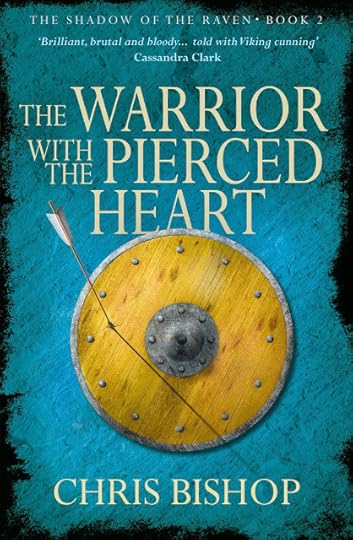
In the second book in the exciting and atmospheric Shadow of the Raven series we rejoin novice monk turned warrior, Matthew as he marches ahead of King Alfred, to Exeter to herald the King’s triumphant return to the city, marking his great victory at Edington.
It should have been a journey of just five or perhaps six days but, as Matthew is to find to his cost, in life the road you’re given to travel is seldom what you wish for and never what you expect.
In this much-anticipated sequel Chris Bishop again deposits the reader slap-bang into the middle of Saxon Britain, where battles rage and life is cheap. An early confrontation leaves Matthew wounded, but found and tended by a woodland-dwelling healer he survives, albeit with the warning that the damage to his heart will eventually take his life.
Matthew faces many challenges as he battles to make his way back to Chippenham to be reunited with King Alfred and also with the woman he wants to make his wife. This is an epic tale of triumph over adversity as we will the warrior with the pierced heart to make it back to those he loves, before it is too late.
Excerpt
PRELUDEMust my conscience to be burdened for ever by all that transpired that first day after we left Chippenham? Am I to be blamed for all those who perished simply because I did as I was ordered? If so, then I must crave forgiveness even though I contend that I was not at fault – my only sin was one of undue haste and that I’ve freely acknowledged before God. Even though I might well have been counted among the number of those who were slain that fateful day, all that occurred still weighs heavy on my soul and thus I would now relate my account of those events –- and all that followed –- and will do so as faithfully as my memory allows.You will recall that I, Matthew, christened Edward, third born son of the noble Saxon Edwulf, had forsaken my commitment to the Holy Church and declined the chance to become a warrior. Lord Alfred, in recognition of all I’d endured and achieved on his behalf, then offered to let me serve at his court as he sought to secure and restore his Kingdom. He even agreed not to oppose my marriage to Emelda, the girl I loved, even though she was, in his eyes and that of many others, both a whore and the daughter of a traitor. My first mission was to march ahead of Alfred’s army and prepare for his triumphant entry into Exeter to mark his great victory at Edington. Thus, with an escort of a dozen men together with Edmund, the boy I’d offered to adopt and whose father my brother had slain, I set off across our still troubled land knowing full well that bands of restless Vikings still roamed free, armed and intent on vengeance. Even so, it should have been a journey of just five or perhaps six days but, as I was to find to my cost, in life the road you’re given to travel is seldom what you wish for – and never what you expect.
CHAPTER ONE
Even as we left Chippenham things did not bode well for our journey. One member of my escort was unwell and had to turn back, little knowing that the pains in his belly would serve to save his life. The weather then turned against us so that we struggled through the wind and rain until forced to seek shelter, thereby losing several hours of precious daylight. Little wonder then that when I saw the chance to make up lost time I was tempted to take it.Perhaps I should have known better than to make haste through such hostile terrain but I was far from being reckless. I sought only to ensure that we reached Exeter in time so, rather than skirt around the forest when we reached it, I ordered my men to follow a trail which led directly through it. The trail was wide with a small stream running beside it and trees steeped high on either side. I knew that these offered the perfect cover for an ambush and was prudent enough to order my men to keep their rank and walk side by side, each of them raising a shield so as to offer protection from both flanks. As Edmund carried no shield I gave him mine then shared the cover of those behind me, walking with them to make a less obvious target. At first everything seemed as it should. There was no sign of any Vikings and I knew that such a large group of armed men had nothing to fear from robbers. Even so, we remained wary as we pushed on hard for the rest of that day hoping not to have to make our camp for the night whilst still within the forest. Perhaps in our haste we grew careless or perhaps we were just unlucky. Either way, we walked into the Viking trap like a linnet flying straight into the talons of the a raven.It was Edmund’s young eyes which saw them first and he at once drew his sword and raised it as high above his head as he could manage. I was not sure what had riled the boy but then caught sight of a glint of light as the rays of the setting sun struck the brightly burnished blade of a sword or perhaps a spearhead. I cannot say which but, like Edmund, I recognised at once what it meant. I turned to give the order to close up, but even before I could speak I was struck by an arrow which took me full in the chest. For a moment I remained standing, shocked by the sudden pain and by the sheer force of the strike. Then I staggered a few paces before falling, stunned and helpless. Although desperate to get up and relay my orders I found that I couldn’t move - I was pinned to the ground like a beetle stranded on its back.Had I breath enough to shout anything it would have been for the others to save themselves. In truth, there was nothing they could do to aid me, and, in any event, they reacted exactly as they were trained to do, turning to defend themselves back to back with their shields raised and their spears poised. Thereafter all I could hear was the dreadful din of battle. I guessed that the Vikings had come down upon us in force. Men were shouting and calling as they locked in combat, some screaming in fear or from whatever madness they find in battle whilst others acknowledged their wounds with groans or shrill cries of pain and anguish. As I listened to all this I was surprised not to feel more pain but then recalled being told that the full agony of death comes only as the end draws nigh – - as if some last, dreadful spasm is needed to force the soul to actually leave the body.With my hand, I reached up and found the shaft of the arrow. I couldn’t see it clearly as my vision was blurred but I could feel it well enough. There was blood from the wound but not as much as I expected, the arrow having blocked the flow of it. Even so, I judged that the arrow head was embedded deeply enough, though I could not be sure exactly how far as part of the shaft had broken when I fell. From all I could tell it had pierced my heart or was so close to it as to make no difference; death would come as soon as it was pulled from my chest, or sooner. Certain that I could not survive the wound, I was tempted to pull it free myself and thereby hasten any final agony and be done with it; but to take my own life thus was against my Christian creed. In deference to my former calling as a novice monk I therefore lay back and prepared to endure what I was sure would follow.During all that time the battle raged around me. I desperately wanted to see how my men fared but all I knew was that which I could hear. There was little comfort in that. Their screams seemed to echo from the trees and I knew that with such numbers set against them they would all be slain or taken soon enough. Even as I listened I kept seeing again that image of young Edmund with his sword held high and I prayed he would be spared even though I knew it was a futile hope; surely none would survive the blood fest which would follow such a crazed attack.It was then, in what I thought to be my final moments, that my spirit seemed to leave my body. I found myself floating over the frenzied battle and looking down upon the slaughter. What I saw saddened me beyond words as my men were being slain and butchered. Like me, two of them had fallen to arrows as the Vikings attacked and they also lay dead or dying whilst the rest fought back against overwhelming odds. The Viking warriors numbered perhaps thirty or more and even having taken so few casualties seemed inclined to show no mercy. For them it was about vengeance, not stealing our supplies or looking for plunder, therefore only blood would serve to satisfy their cravings. Having split my small force, they had only to run the few survivors to ground to complete their slaughter. I watched as a man named Eagbert, whom I had chosen personally for the mission, ran towards the cover of the trees but was caught and skewered by spears from two sides at once. As he fell to his knees they twisted the shafts to increase his pain. Athelstan, another fine warrior, was slain with an axe blow to his forehead which all but cleaved his skull in two, whilst his brother, Aethelred, had been strung up against a tree and was being disembowelled, screaming as they pulled the entrails from his body.I was helpless to assist but watched as the Viking warriors made themselves busy probing the bodies of the fallen with their swords and spear points to make certain that none still lived. Then I noticed that young Edmund had indeed been spared. I was at once grateful for that small mercy and could only assume that he had perhaps been recognised by one of his Viking kin. Still looking down on them, I watched as the Vikings then started to strip the bodies, taking jewellery, weapons and anything else worth stealing. In my case they roughly turned my body over and removed my still sheathed sword ‒- the one Edwin had given me and which had once belonged to our beloved father. They also took my birth ring, my gold crucifix and my purse before stripping away my fleece jerkin and my shoes to leave me naked but for my undershirt and leggings. They would have taken all except that my shirt had been soiled by blood and the leggings by the fact that I’d loosened my bowels as I fell. I recall looking down on two men who were standing over me at that point, but they didn’t finish me. Either they thought me dead already or reckoned that I couldn’t hope to survive such a dreadful wound and would die more slowly if left for it to take its course. Instead, they kicked my ribs then spat in my face before leaving me to my fate.
I cannot now say how much of what I recall after that is true. Possibly it was just a dream or a manifestation of my tortured mind yet, if pressed, I would swear that I was engulfed in a pool of utter darkness through which I seemed to swim as though in the deep, dark waters of a lake at night. There I saw the faces of many men I recognised but knew to have died, some of them many years before. Edwin was among them, as was my father, their arms waving as if to welcome me. I moved towards them, struggling to pull myself through the darkness, but, as I drew closer, I realised that they were not beckoning me as I’d thought, rather they were ushering me away, imploring me to turn back.After that I seemed to wake. My limbs had grown cold and numb by then but the pain in my chest was much more intense. I shivered and convulsed in a way I’d seen dying men do and wondered how long it would take for me to die. I hoped it would be soon as all was quiet by then and I was probably the only one still living, the Vikings having gathered up their spoil and gone. Next would come the crows and the wolves and the other wild beasts of the forest intent upon feeding on the corpses which were still strewn across the battlefield. To be taken thus whilst still alive would test my faith to the limit. It was a terrible way to die and I had the means to avoid it by simply pulling the arrow from my chest.As I lay there I recall that I could hear my own breathing, which was rasped and hoarse, sounding like a chain being drawn across a pebbled courtyard. I felt again for the shaft of the arrow and calmed myself when I found it, certain that when removed it would rip my heart from my breast so that death would then be instant. Thus reassured, I uttered a few short prayers before closing my eyes and prepared to surrender myself to God.
Amazon • hive.co.uk • Waterstones •Wordery
Chris Bishop
 Chris Bishop is a retired chartered surveyor who has pursued his love of writing for as long as he can remember. He is an intrepid traveller and a retired Fellow of the Royal Institution of Chartered Surveyors. He is married with two children and four granddaughters and lives in London.
Chris Bishop is a retired chartered surveyor who has pursued his love of writing for as long as he can remember. He is an intrepid traveller and a retired Fellow of the Royal Institution of Chartered Surveyors. He is married with two children and four granddaughters and lives in London. Chris loves to hear from readers, you can find him: WebsiteTwitter
Published on July 04, 2018 23:00
July 3, 2018
33 Victorian superstitions you might not know by Kerry A Waight #Victorian #History @Storiesofthen
They’re a Superstitious Lot, Those VictoriansBy Kerry A Waight
While the Victorian Era was a period of technological advancement, encompassing as it did the end of the Industrial Revolution, and formality, it was also a period of superstitions, many of which are still observed today.
Death
In a period where medical cures were never as sure as they are today, there were, understandably, a lot of superstitions around death and dying. Many researchers say that the Victorians were, in fact, obsessed with death and the afterlife.
How to know to expect trouble.
There were many signs to give you the ‘heads up’ to expect death, either to yourself or someone close to you.
1.) Seeing yourself in a dream is a sign that you will die.
2.) A dream of a baby being born is an omen that someone will die.
3.) Large drops of rain are an indication that there has been a death, as is a bird pecking on your window.4.) Seeing an owl during the day is a foreteller of death.
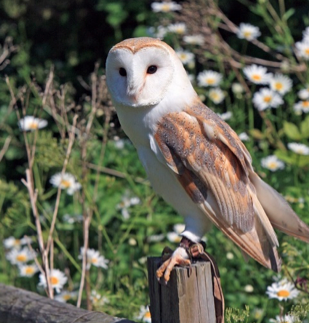
5.) If a picture falls off a wall, someone you know will die.
6.) Finding a single snowdrop flower in the garden.7.) If you smell roses when there aren’t any around, there will be a death.

8.) Seeing a sparrow land on a piano foretells of death.
9.) When someone in your house is sick, you don’t want to hear a dog howling—it’s a bad omen. If you turn reach under the bed to turn a shoe over the omen can be reversed.
Death and darkness
Of course, you needed to protect yourself from the dead and dark entities, even your family members.
10.) The dead were carried out of the home feet first so that the dead could not look back and call any remaining relatives to follow them into death.
11.) Family photographs were often turned face down so that the dearly departed could not possess any of the subjects of the photo.12.) Don’t speak ill of the dead— they will come back to haunt you. You may also suffer misfortune.

13.) If you need to yawn, make sure you cover your mouth. You don’t want your spirit to leave and be replaced by the devil.
14.) Speaking of evil, planting yellow flowers in the garden will protect the family from witches.
There were also things to avoid doing to spare either yourself or others.
15.) Placing new shoes on a table will lead to the death to the wearer within a year. My paternal grandmother was a very superstitious woman. This is the one that sticks in my mind the most. To this day, I cannot put new shoes on a table.
16.) If you open an umbrella indoors, you may lead to the murder of a family member.
17.) While waiting for the funeral, all mirrors in the house were covered with heavy black material so that the soul of the departed could not be trapped in the mirror
18.) To ward off bad luck following a death, it was common practice to stop the clocks in the house at the time of death and not starting them again until after the funeral.
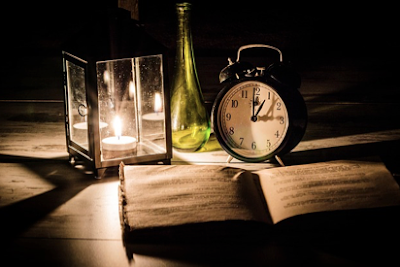
19.) Apparently, you could protect both people and animals from death in a house where many people have died if you tie a black ribbon on everything alive that enters your house, including your animals.
Funerals and burials
20.) Coming across a funeral procession in Victorian times was very bad luck indeed. If possible, you would, and should, turn around and go the other way. Failing that, grabbing a button while the procession passed may save you from the bad luck.
21.) It is bad luck to lock the house after a funeral procession left the house.

23.) If you don’t hold your breath while you are passing by a graveyard, you will not be buried. Given that burial and not cremation was the tradition in the Western World at the time, I would have to presume that your body was not around to be buried.
Life
Nice things!
Not all superstitions were around death, dying and demons though.
24.) Absently rocking an empty cradle means that a baby is on the way.
25.)The sound of a robin singing on a bride’s wedding day was very good luck because they were an omen of joy.
26.) Victorian wedding guests threw rice, grain or birdseed at the couple as they left the church to ensure fertility.

27.) Putting a garment on inside out is good luck.
28.)If a little spider was found on the wedding dress on the morning of the wedding, the bride would never be without money.
29.)Many couples were married in the home. Good luck icons such as bells, doves, wishbones were used to decorate the area where they exchanged vows .
30.) Throwing the first Shrove Tuesday pancake to the hens will give you plenty of eggs for the rest of the year.
31.) Something old, something new, something borrowed and something blue? “Blue was the colour sacred to Virgin Mary. Old symbolized that she should still love and stay attached to her old life, new indicated success in her new life, borrowing indicated that friends would be helpful and faithful when needed and blue for symbol of loyalty and constancy” (The Victorian Era 2018).
32.) Turning money over in your pocket while staring at a new moon will double your money.
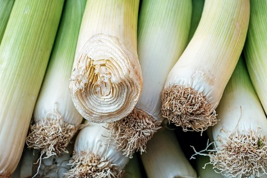
As you can imagine, there are many more superstitions out there from the Victorian era. While many may laugh at them, how many of us don’t put umbrella’s up inside, throw rice or confetti at a wedding—or follow any type of superstition, even though our modern mind tells us it isn’t true? I, for one, have no intention of stepping on a crack and breaking my mother’s back.
Kerry A Waight
 Married with two grown children, Kerry is a retired History and Legal Studies teacher. She is also a genealogist, with the material for the novel in progress coming from her own family records. Published for the first time this year in the anthology Heart of a Child, Kerry is a largely writer of historical fiction, with some non-fiction thrown in around research. With an interest in not only history but the paranormal, Kerry is working not only on a new historical novel and short story, but a paranormal short story under the name Kerriann Waight.
Married with two grown children, Kerry is a retired History and Legal Studies teacher. She is also a genealogist, with the material for the novel in progress coming from her own family records. Published for the first time this year in the anthology Heart of a Child, Kerry is a largely writer of historical fiction, with some non-fiction thrown in around research. With an interest in not only history but the paranormal, Kerry is working not only on a new historical novel and short story, but a paranormal short story under the name Kerriann Waight.Kerry loves to hear from readers, you can find her: Website Facebook Twitter
Heart of a Child
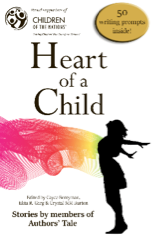 Whether you want to take a trip through time, go on an adventure in your back yard, or feel a burst of excitement only to return to an adult reality, each story has something for every reader who wants to feel like a child or be part of a life many children have led before.
Whether you want to take a trip through time, go on an adventure in your back yard, or feel a burst of excitement only to return to an adult reality, each story has something for every reader who wants to feel like a child or be part of a life many children have led before.Take a trip down memory lane or pull your child into your lap and see the world through their eyes. In this second anthology written by members of Authors’ Tale, both light and heavy themes bring out the child in almost every genre.
This year's anthology features many stories about young hearts and some written for young-at-hearts. These tales will make any reader feel nostalgic or even open their eyes to something they never considered—something that will challenge their view of what childhood can really be like.
Amazon
References
Beliefs & Superstitions: The Haunted House. na. Superstitions. Accessed June 26th, 2018. https://beliefsandsuperstitions.weebl...'. 2013. Victorian Superstitions. 31st July. Accessed June 26th, 2018. https://classicbookreader.wordpress.c..., Aleandra. na. Superstitious Beliefs of Victorian Society. Accessed June 26th, 2018. https://classroom.synonym.com/superst..., Terry. 2007. Horrible Histories: Vile Victorians. London: Scholastic Children's Books. Accessed June 21st, 2018.'Etcetera'. 2012. Superstitions of the Victorian Era. 6th June. Accessed June 26th, 2018. http://www.infobarrel.com/Superstitio... of Oakgrove Cemetery. 2008. Victorian Funeral Customs and Superstitions. Accessed June 26th, 2018. https://friendsofoakgrovecemetery.org..., Rosa. 2011. Superstitions . 17th October. Accessed June 26th, 2018. http://thevictoriantimes.blogspot.com... Victorian Era. 2018. Victorian Wedding Lore and Superstition. Accessed June 26th, 2018. http://www.victorian-era.org/victoria....
<!-- /* Font Definitions */ @font-face {font-family:Times; panose-1:2 0 5 0 0 0 0 0 0 0; mso-font-charset:0; mso-generic-font-family:auto; mso-font-pitch:variable; mso-font-signature:3 0 0 0 1 0;} @font-face {font-family:"MS 明朝"; mso-font-charset:78; mso-generic-font-family:auto; mso-font-pitch:variable; mso-font-signature:-536870145 1791491579 18 0 131231 0;} @font-face {font-family:"Cambria Math"; panose-1:2 4 5 3 5 4 6 3 2 4; mso-font-charset:0; mso-generic-font-family:auto; mso-font-pitch:variable; mso-font-signature:-536870145 1107305727 0 0 415 0;} @font-face {font-family:Cambria; panose-1:2 4 5 3 5 4 6 3 2 4; mso-font-charset:0; mso-generic-font-family:auto; mso-font-pitch:variable; mso-font-signature:-536870145 1073743103 0 0 415 0;} @font-face {font-family:"\0022times new roman\0022"; panose-1:0 0 0 0 0 0 0 0 0 0; mso-font-alt:"Times New Roman"; mso-font-charset:0; mso-generic-font-family:roman; mso-font-format:other; mso-font-pitch:auto; mso-font-signature:0 0 0 0 0 0;} /* Style Definitions */ p.MsoNormal, li.MsoNormal, div.MsoNormal {mso-style-unhide:no; mso-style-qformat:yes; mso-style-parent:""; margin:0cm; margin-bottom:.0001pt; mso-pagination:widow-orphan; font-size:12.0pt; font-family:Cambria; mso-ascii-font-family:Cambria; mso-ascii-theme-font:minor-latin; mso-fareast-font-family:"MS 明朝"; mso-fareast-theme-font:minor-fareast; mso-hansi-font-family:Cambria; mso-hansi-theme-font:minor-latin; mso-bidi-font-family:"Times New Roman"; mso-bidi-theme-font:minor-bidi;} .MsoChpDefault {mso-style-type:export-only; mso-default-props:yes; font-family:Cambria; mso-ascii-font-family:Cambria; mso-ascii-theme-font:minor-latin; mso-fareast-font-family:"MS 明朝"; mso-fareast-theme-font:minor-fareast; mso-hansi-font-family:Cambria; mso-hansi-theme-font:minor-latin; mso-bidi-font-family:"Times New Roman"; mso-bidi-theme-font:minor-bidi;} @page WordSection1 {size:595.0pt 842.0pt; margin:72.0pt 90.0pt 72.0pt 90.0pt; mso-header-margin:35.4pt; mso-footer-margin:35.4pt; mso-paper-source:0;} div.WordSection1 {page:WordSection1;} </style>
Published on July 03, 2018 23:00
The Coffee Pot Book Club
The Coffee Pot Book Club (formally Myths, Legends, Books, and Coffee Pots) was founded in 2015. Our goal was to create a platform that would help Historical Fiction, Historical Romance and Historical
The Coffee Pot Book Club (formally Myths, Legends, Books, and Coffee Pots) was founded in 2015. Our goal was to create a platform that would help Historical Fiction, Historical Romance and Historical Fantasy authors promote their books and find that sometimes elusive audience. The Coffee Pot Book Club soon became the place for readers to meet new authors (both traditionally published and independently) and discover their fabulous books.
...more
...more
- Mary Anne Yarde's profile
- 159 followers



